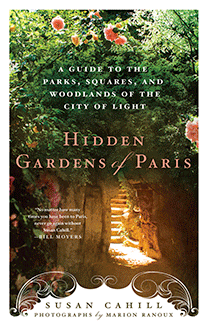By John Churchill
Susan Cahill understands the accretion and expression of meaning. This “guide to the parks, squares and woodlands of the City of Light” spirals out from the Île de la Cité like the arrondissements themselves, taking the reader on a tour of the city’s cultural history by way of its green spaces. There are forty “commentaries,” not all of them on hidden gems: the Bois de Boulogne and the Tuileries find their entries, as well as La Vallée Suisse and the Students’ Garden at l’École Normale Supérieure. But in each spot, large or small, Cahill takes the reader into its history, its associations with figures of fame and notoriety, its meaning as a human place. And she situates that meaning within the rich texture of the city itself and the reader’s own sense of things. This book connects its readers with what Cahill calls “repositories of the city’s collective memory.”
The writing bristles with historical allusion. One entry begins, “Until 1831, when it was destroyed in a riot . . . ,” and goes on to connect a spot near Notre Dame with the life of the man who became Pope John XXIII and his affection for Paris. Henry IV turns up over and over, as do characters from Henry James and Flaubert. In connection with the Square Paul-Langevin we get an evocation of late medieval academic Paris, through a brief meditation on Francois Villon, and his “lawless life of a perpetual student in the lawless Latin Quarter.” Wherever we are invited to sit and enjoy the beauty, there appears, to the eye of history scenes of violence and death, of loves wholesome and illicit, and the vanished industry of those who wrote, painted, ruled, and rioted here.
The Nazis make their appearance in the Jardin de Luxembourg, which they seem to have nurtured well until they dug them up for fortifications. We come across Simone Weil, Tony Judt, Hemingway, the Romans, the perpetrators of the St. Bartholomew’s Day massacre, the communards of 1871, and innumerable others. Of course, she quotes Villon: “Mais ou sont les neiges d’antan?” To Cahill’s eye, and through her to the sensibility of her reader, they are everywhere. In this juxtaposition she revels: These gardens are places of loveliness, sites of retreat, graceful meditative refuges. And yet they are also scenes of gladiatorial games and lethal battles for power, to say nothing of the petty betrayals and waste that fleck the story of humanity. Cahill puts this contrast before us, over and over again, asking the reader to face and ponder the cohabitation of beauty and ruin.
And yet the book is a delight. Every “commentary” includes a sketch of the quartier, with suggestions about bookshops, bars, and bistros. So it really is a functional guidebook. Handy, sturdy, and richly illustrated with contemporary photographs, it’s a volume for the pilgrim’s book bag, as well as the nightstand.
John Churchill is Secretary and CEO of the Phi Beta Kappa Society.




